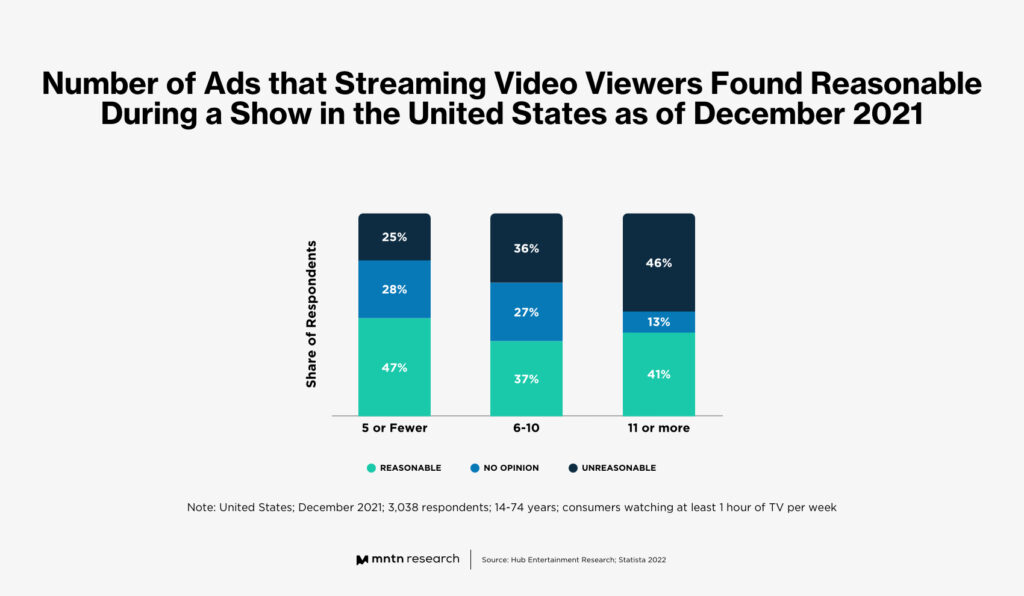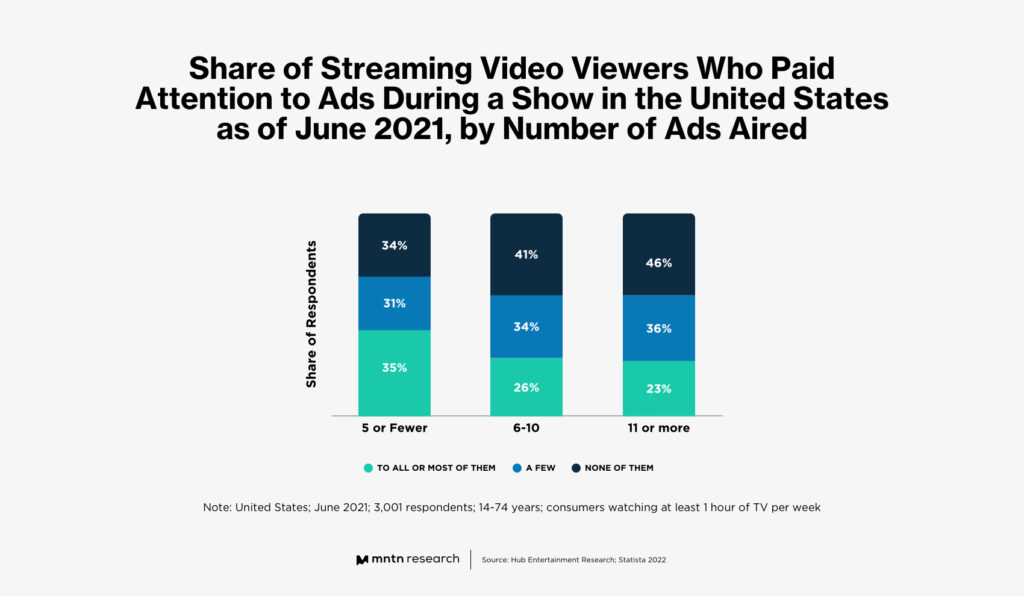Research Digest
Ad Loads Can Affect Viewer Attention Spans
by Isabel Greenfield4 min read
Abstract
- Streamers are willing to watch ads but find that 5 or fewer per show is more reasonable.
- Not only does an increase in ads lead to frustration, but it also leads to a decrease in attention paid to the ads, limiting ad recall.
- Networks are looking to balance their ad loads for profits, especially after the dip in ad sales at the start of the pandemic, as well as viewer satisfaction.
- The number of ads is not the only indicator of how a viewer will react. Relevancy and frequency of the ads are also important factors in user satisfaction.
There is a delicate balance between ad loads, viewer attention, and streaming profits.

As more Connected TV apps have launched over the past few years, streaming services are still figuring out the ideal ad load. While many viewers are willing to watch some ads to see the content they like and to pay less (or nothing) for a subscription, there is a limit. About half of streamers believe five or fewer ads during one show are reasonable, with tolerance decreasing with more ads, per a survey done by Hub Entertainment Research.
The research also found that the ad load is an important indicator of attention. As the number of ads increased, viewers were less likely to remember all of them, reporting that they only remember a few or even none at all.
The research suggests that streaming services with ad-supported tiers need to be mindful of how many impressions they are selling per show. Viewers will likely shift away from services that have too many ads in favor of lighter ad loads. Advertisers won’t reap the benefits of advertising within an ad-heavy service as viewers won’t pay attention to their ad.

Which Networks Have the Lightest Ad Load
Networks must look to strike the right balance to achieve business goals, meet advertiser demand, and also ensure a pleasant viewing experience for streamers. An analysis of ad loads in 2021 showed that each network approaches its ad loads differently, while they look to adjust ad balances that had been affected by the decreased ad spend due to the pandemic. Paramount+ clocked in with the highest ad load with an average of 17 ads per show, while NBCUniversal’s Peacock had the lowest at 4.6 ads per show.
Relevancy and Frequency in Ads
When it comes to viewer ad tolerance, it’s overly simplistic to say that the only factor that affects this tolerance and overall ad attention is the number of ads. Other factors including the relevancy of the ads and the frequency of a specific ad spot play a larger role in user perception of ads.
When asked about the number of OTT ads within a given program on Discovery+, viewers noted that they saw more ads than in other streaming services. Surprisingly, however, they weren’t dissatisfied. They described the ads as informative, consistent with the type of show, and “relevant for me,” more so than other platforms, like Hulu and HBO Max. The results highlight the importance of relevancy when it comes to ad load. Viewers will watch more ads and be more satisfied if those ads speak to their interests. Discovery+ is a prime example as its content surrounds lifestyle, home, and cooking, which lends itself to easy ad alignment. While viewers were aware that the ad loads were higher, it was the relevancy that affected their perception more than the number of ads.
This, too, requires balance. While advertisers should be sure to reach their target audience for optimal reception, the frequency at which they are targeted is also essential. Internet users when surveyed shared that seeing the same ad repeatedly is more frustrating than too many ads. The same survey shows that repeating ads also fueled frustration more than ads that weren’t relevant to the viewer.
Viewers Want an Ad-Supported Option
The variety of ad loads doesn’t mean that people are abandoning ad-supported channels, however. Viewership of ad-supported channels is increasing. eMarketer forecasts that 41.6% of the population will watch ad-supported channels by the end of 2022 with a projected increase to 49.5% by the end of 2026. As viewers have cut the cord or turned to streaming to reduce the amount they are spending on cable, they are loath to rack up the same costs by subscribing to multiple streaming services. Those monthly fees can add up quickly. Instead, they are willing to watch ads in exchange for a lesser monthly fee or no fee at all. When surveyed, 41% of TV viewers said that they prefer a free-with-ads model, while another 26% would like to be given the option between a paid and ad-supported package. The networks are following suit, rolling out free or lower-priced tiers to their formerly limited package options.
Conclusion
Ad-supported content is not only here to stay, but also a growing offering within the streaming world. Striking the right balance of how many CTV ads per hour of content is an essential task for networks to ensure viewers have a pleasant streaming experience and advertisers get their message across to an attentive audience.
Subscribe to the MNTN Research Weekly
Sign up to receive a weekly feed of curated research, sent straight to your inbox.
Resources
3 Paramount+ Tops In Streaming Ad Load In 2021, Peacock Is The Lowest (MediaPost)
4 Relevance Trumps High Streamer Ad Loads, Discovery+ Is Prime Example (MediaPost)
5 Overtargeted video ads more frustrating than high ad load, US internet users say (eMarketer)
6 AVOD Viewers (eMarketer)
7 Consumer Attitudes Toward Digital Advertising 2021 (eMarketer)